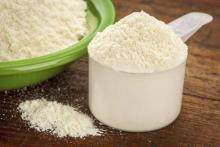MIAMI BEACH – Acne on the face and trunk in adolescents could be associated with the use of whey protein supplements, according to Dr. Jonette E. Keri.
Teenage boys, especially, may use whey protein supplements in an effort to increase muscle mass or gain weight, Dr. Keri of the University of Miami said at the South Beach Symposium.
She cited a 2012 case series of five male teenage athletes aged 14-18 years who were using whey protein shakes or reconstituted powder. The teens presented with moderate to severe acne that responded poorly to standard treatment, but four of the five experienced clearing of the acne upon discontinuation of the whey protein supplement.
All five had been treated unsuccessfully with traditional therapies, including oral antibiotics, topical retinoids, and benzoyl peroxide. One teen stopped using the whey protein immediately after being counseled to do so, and he experienced improvement. Two teens didn’t stop using whey protein immediately but experienced improvement in their acne when they did discontinue it. Another teen experienced clearing after discontinuing the whey protein during a second course of isotretinoin therapy, and the fifth was lost to follow-up (Cutis 2012;90:70-2).
One of the teens who cleared after discontinuing the whey protein experienced a flare of the acne when he reinitiated supplementation, Dr. Keri said.
Three of the boys were trying to build muscle for football and two were trying to gain weight, which underscores the importance of asking teens about supplement use, she noted, adding that, importantly, it’s not just boys who are affected.
In fact, a Brazilian study of 30 patients showed a very strong association between the onset or exacerbation of acne and initiation of whey protein use – and the finding was more pronounced among women than men, and among those without a personal or family history of acne (An. Bras. Dermatol. 2013;88:907-12).
In that study, subjects were examined on three occasions and followed for 60 days.
“They went the gym, wanted to work out a little bit and get bigger, took some whey, and broke out in acne,” Dr. Keri said.
Although acne breakouts won’t happen to everyone who uses whey protein, it’s something worth considering in teens, particularly if they fail to respond to standard therapies, she said.
Although the reason for the association hasn’t yet been “teased out,” whey protein is derived from cow’s milk, and it appears to be related to activation of the insulin cascade, explained Dr. Keri.
Dr. Nanette B. Silverberg of the Mount Sinai Health System, New York, author of the case series involving the five male athletes, noted that milk is known to be associated with acne and suggested that whey protein may be the fraction of dairy products that promote acne formation.
Similarly, based on findings from a study of five adult male bodybuilders who developed moderate to severe facial or truncal acne after consuming whey protein, Dr. Thierry Simonart of Brussels noted that the observations are “in line with biochemical and epidemiological data supporting the effects of milk and dairy products as enhancers of insulin/insulin-like growth factor 1 signaling and acne aggravation” (Dermatology 2012;225:256-8).
Dr. Kerri reported having no relevant disclosures.


